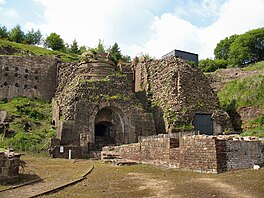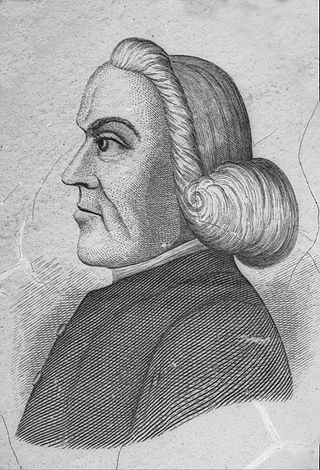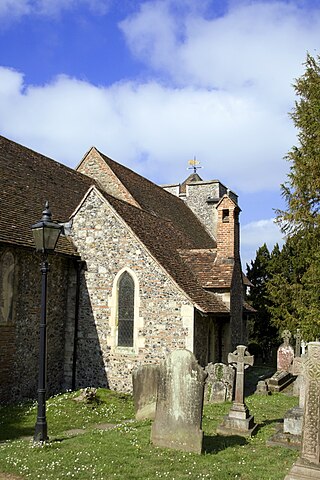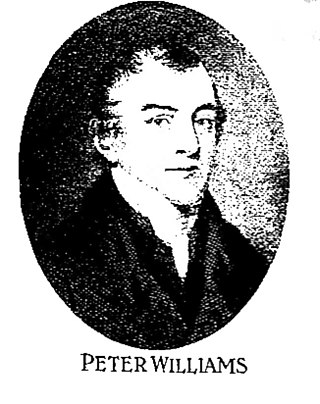
The early modern period in Wales is the period in the history of Wales from 1500 to 1800.

The early modern period in Wales is the period in the history of Wales from 1500 to 1800.
Following Henry VIII's break with Rome and the Pope, Wales for the most part followed England in accepting Anglicanism, although a number of Catholics were active in attempting to counteract this and produced some of the earliest books printed in Welsh.[ citation needed ]
In 1567, Richard Davies, William Salesbury, and Thomas Huet completed the first modern translation of the New Testament and the first translation of the Book of Common Prayer (Welsh : Y Llyfr Gweddi Gyffredin). In 1588, William Morgan completed a translation of the whole Bible. These translations were important to the survival of the Welsh language and had the effect of conferring status on Welsh as a liturgical language and vehicle for worship. This had a significant role in its continued use as a means of everyday communication and as a literary language down to the present day despite the pressure of English. [1]
In 1588, William Morgan produced the first complete translation of the Welsh Bible. [2] [3] Morgan's Bible is one of the most significant books in the Welsh language, and its publication greatly increased the stature and scope of the Welsh language and literature. [2]
| History of Wales |
|---|
 |
Bishop Richard Davies and dissident Protestant cleric John Penry introduced Calvinist theology to Wales. Calvinism developed through the Puritan period, following the restoration of the monarchy under Charles II, and within Wales' Methodist movement. However, few copies of Calvin's works were available before the mid-19th century. [4]
The 18th century also saw the Welsh Methodist revival, led by Daniel Rowland, Howell Harris and William Williams Pantycelyn. [5] Nonconformity was a significant influence in Wales from the eighteenth to the twentieth centuries. The Welsh Methodist revival of the 18th century was one of the most significant religious and social movements in the history of Wales. The revival began within the Church of England in Wales and at the beginning remained as a group within it, but the Welsh revival differed from the Methodist revival in England in that its theology was Calvinist rather than Arminian. In the early 19th century the Welsh Methodists broke away from the Anglican church and established their own denomination, now the Presbyterian Church of Wales. This also led to the strengthening of other nonconformist denominations, and by the middle of the 19th century, Wales was largely Nonconformist in religion. This had considerable implications for the Welsh language as it was the main language of the nonconformist churches in Wales. The Sunday schools which became an important feature of Welsh life made a large part of the population literate in Welsh, which was important for the survival of the language as it was not taught in the schools. Welsh Methodists gradually built up their own networks, structures, and even meeting houses (or chapels), which led eventually to the secession of 1811 and the formal establishment of the Calvinistic Methodist Presbyterian Church of Wales in 1823. [6] The Welsh Methodist revival also had an influence on the older nonconformist churches, or dissenters the Baptists and the Congregationalists who in turn also experienced growth and renewal. As a result, by the middle of the nineteenth century, Wales was predominantly a nonconformist country.[ citation needed ]
Wales was overwhelmingly Royalist in the Wars of the Three Kingdoms in the early 17th century, though there were some notable exceptions such as John Jones Maesygarnedd and the Puritan writer Morgan Llwyd. [1] Wales was an important source of men for the armies of King Charles I of England, [7] though no major battles took place in Wales. The Second English Civil War began when unpaid Parliamentarian troops in Pembrokeshire changed sides in early 1648. [8] Colonel Thomas Horton defeated the Royalist rebels at the battle of St. Fagans in May and the rebel leaders surrendered to Cromwell on 11 July after the protracted two-month siege of Pembroke.
Education in Wales was at a very low ebb in this period, with the only education available being in English while the majority of the population spoke only Welsh. In 1731, Griffith Jones started circulating schools in Carmarthenshire, held in one location for about three months before moving (or "circulating") to another location. The language of instruction in these schools was Welsh. By Griffith Jones' death, in 1761, it is estimated that up to 250,000 people had learnt to read in schools throughout Wales. [9]

The end of the 18th century saw the beginnings of the Industrial Revolution, and the presence of iron ore, limestone and large coal deposits in south-east Wales meant that this area soon saw the establishment of ironworks and coal mines, notably the Cyfarthfa Ironworks and the Dowlais Ironworks at Merthyr Tydfil.[ citation needed ]

Aberdare is a town in the Cynon Valley area of Rhondda Cynon Taf, Wales, at the confluence of the Rivers Dare (Dâr) and Cynon. Aberdare has a population of 39,550. Aberdare is 4 miles (6 km) south-west of Merthyr Tydfil, 20 miles (32 km) north-west of Cardiff and 22 miles (35 km) east-north-east of Swansea. During the 19th century it became a thriving industrial settlement, which was also notable for the vitality of its cultural life and as an important publishing centre.

The history of what is now Wales begins with evidence of a Neanderthal presence from at least 230,000 years ago, while Homo sapiens arrived by about 31,000 BC. However, continuous habitation by modern humans dates from the period after the end of the last ice age around 9000 BC, and Wales has many remains from the Mesolithic, Neolithic, and Bronze Age. During the Iron Age the region, like all of Britain south of the Firth of Forth, the culture had become Celtic, with a common Brittonic language. The Romans, who began their conquest of Britain in AD 43, first campaigned in what is now northeast Wales in 48 against the Deceangli, and gained total control of the region with their defeat of the Ordovices in 79. The Romans departed from Britain in the 5th century, opening the door for the Anglo-Saxon settlement. Thereafter, the culture began to splinter into a number of kingdoms. The Welsh people formed with English encroachment that effectively separated them from the other surviving Brittonic-speaking peoples in the early middle ages.

William Williams, Pantycelyn, also known as William Williams, Williams Pantycelyn, and Pantycelyn, was generally seen as Wales's premier hymnist. He is also rated among the great literary figures of Wales, as a writer of poetry and prose. In religion he was among the leaders of the 18th-century Welsh Methodist revival, along with the evangelists Howell Harris and Daniel Rowland.

Nonconformists were Protestant Christians who did not "conform" to the governance and usages of the state church in England, and in Wales until 1914, the Church of England.

William Morgan was a Welsh Bishop of Llandaff and of St Asaph, and the translator of the first version of the whole Bible into Welsh from Greek and Hebrew.

The Music of Wales, particularly singing, is a significant part of Welsh national identity, and the country is traditionally referred to as "the land of song".
The term high church refers to beliefs and practices of Christian ecclesiology, liturgy, and theology that emphasize "ritual, priestly authority, [and] sacraments". Although used in connection with various Christian traditions, the term originated in and has been principally associated with the Anglican tradition, where it describes churches using a number of ritual practices associated in the popular mind with Roman Catholicism and Eastern Orthodoxy. The opposite tradition is low church. Contemporary media discussing Anglican churches often prefer the terms evangelical to low church and Anglo-Catholic to high church, even though their meanings do not exactly correspond. Other contemporary denominations that contain high church wings include some Lutheran, Presbyterian, and Methodist churches.

The Welsh Methodist revival was an evangelical revival that revitalised Christianity in Wales during the 18th century. Methodist preachers such as Daniel Rowland, William Williams and Howell Harris were heavily influential in the movement. The revival led eventually to the establishment of the Welsh Calvinistic Methodists as a denomination and it also revitalised older dissenting churches.
The Presbyterian Church of Wales, also known as the Calvinistic Methodist Church, is a denomination of Protestant Christianity based in Wales.
Robert Tudur Jones, better known as R. Tudur Jones, was a Welsh nationalist and one of the country's leading theologians. His nationalistic stance, combined with Calvinist doctrine, created an integrated vision that was significant to the religious life of Christian Wales in the later half of the 20th century.

Parts of the Bible have been translated into Welsh since at least the 15th century, but the most widely used translation of the Bible into Welsh for several centuries was the 1588 translation by William Morgan, Y Beibl cyssegr-lan sef Yr Hen Destament, a'r Newydd as revised in 1620. The Beibl Cymraeg Newydd was published in 1988 and revised in 2004. Beibl.net is a translation in colloquial Welsh which was completed in 2013.
Morgan Llwyd was a Puritan Fifth Monarchist and Welsh-language poet and prose author.

The Reports of the Commissioners of Inquiry into the State of Education in Wales, commonly referred to in Wales as the "Treason of the Blue Books" or "Treachery of the Blue Books" or just the "Blue Books" are a three-part publication by the British Government in 1847, which caused uproar in Wales for disparaging the Welsh; being particularly scathing in its view of the nonconformity, the Welsh language and the morality of the Welsh people in general. The Welsh sobriquet Brad y Llyfrau Gleision was from the name of a play satirising the reports, and those who gave evidence to the inquiry, which was published seven years after the reports. The Welsh Academy Encyclopaedia of Wales says that the name "took hold of the public imagination to such an extent that ever since the report has been known by that name".

Bethlehem is a tiny farming village in the county of Carmarthenshire, Wales, lying in the Tywi Valley northeast of Llandeilo and southwest of Llangadog but on the opposite side of the river from the busy London to Haverfordwest road, the A40.

Religion in Wales has become increasingly diverse over the years. Christianity was the religion of virtually all of the Welsh population until the late 20th century, but it rapidly declined throughout the early 21st century. Today, a plurality (46.5%) of people in Wales follow no religion at all.

Welsh-language literature has been produced continuously since the emergence of Welsh from Brythonic as a distinct language in around the 5th century AD. The earliest Welsh literature was poetry, which was extremely intricate in form from its earliest known examples, a tradition sustained today. Poetry was followed by the first British prose literature in the 11th century. Welsh-language literature has repeatedly played a major part in the self-assertion of Wales and its people. It continues to be held in the highest regard, as evidenced by the size and enthusiasm of the audiences attending the annual National Eisteddfod of Wales, probably the largest amateur arts festival in Europe, which crowns the literary prize winners in a dignified ceremony.

Representing 43.6% of the Welsh population in 2021, Christianity is the largest religion in Wales. Wales has a strong tradition of nonconformism, particularly Methodism. From 1534 until 1920 the established church was the Church of England, but this was disestablished in Wales in 1920, becoming the still Anglican but self-governing Church in Wales.
Nonconformity was a major religious movement in Wales from the 18th to the 20th centuries. The Welsh Methodist revival of the 18th century was one of the most significant religious and social movements in the modern history of Wales. The revival began within the Church of England in Wales, partly as a reaction to the neglect generally felt in Wales at the hands of absentee bishops and clergy. For two generations from the 1730s onwards the main Methodist leaders such as Howell Harris, Daniel Rowland and William Williams Pantycelyn remained within the Church of England, but the Welsh revival differed from the Methodist revival in England in that its theology was Calvinist rather than Arminian. Methodists in Wales gradually built up their own networks, structures, and meeting houses, which led, at the instigation of Thomas Charles, to the secession of 1811 and the formal establishment of the Calvinistic Methodist denomination in 1823.

The history of Christianity in Britain covers the religious organisations, policies, theology and popular religiosity since ancient history.

Peter Williams was a prominent leader of Welsh Calvinistic Methodism in the eighteenth century, best known for publishing Welsh-language bibles and bible commentary.